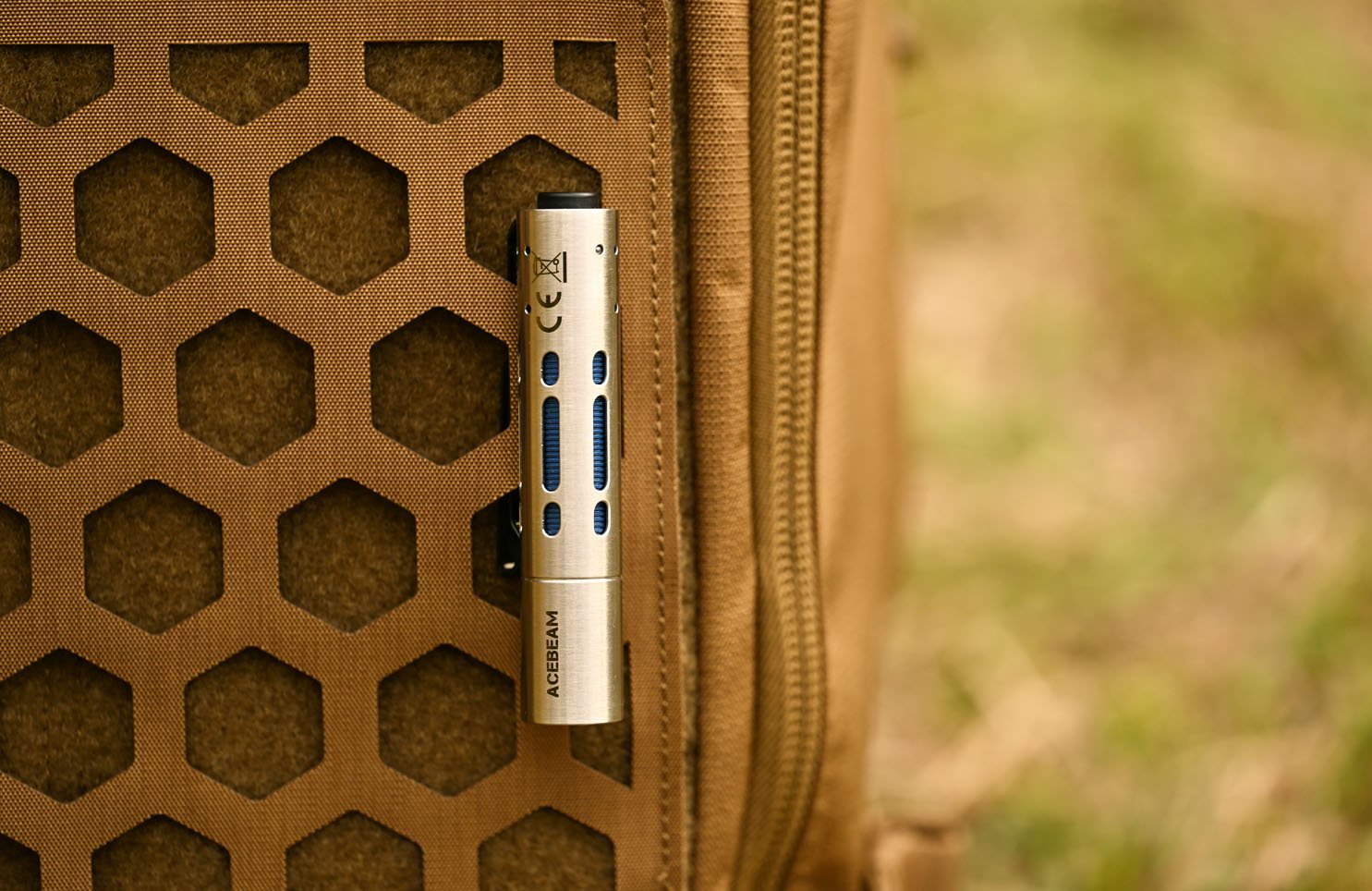Introduction
Things that try to do two jobs are often mediocre at both, so when I was offered a review sample of the Acebeam Rider RX I was sceptical. You see, this particular torch is marketed not only as an EDC torch but also a fidget toy. And the immediate thought that comes to mind is what compromises had to be made for it to be both?
Acebeam is a company that thinks things through in their designs and implementations and I was interested to see how they went about it, so I accepted the sample and will be presenting my findings and thoughts in this article.

Let's delve into this review and find out if the Acebeam Rider RX is a good EDC torch. Fidget toy. Both.
Unboxing
The Acebeam Rider RX comes in a simple white box, with a clear window at the front through which you can see the torch. The front of the box also states the brand and model while the back has the company information and various certifications and QR codes.


The two sides have the company logo and the 5 year warranty, respectively. The top and bottom of the box are plain white.


Inside the box, we find the torch, in a clear, moulded plastic that holds it in place and under that we find the accessories.
The accessories include the user manual, a lanyard, spare o-rings and the short USB-A to USB-C charging cable.


The manual unfolds to a single sheet of paper. One side of it is written in English and the other side is in Chinese. In the following photo you can see the English side.

The construction of the Acebeam Rider RX includes an outer tube, made of stainless steel and an inner tube made of aluminium. The outer tube comes in 4 different finishes that you can see in the following photo, while the inner tube is always anodized blue.

The sample that was sent to me is the blue version of the Acebeam Rider RX which is the most discrete one, as the outer stainless steel tube does not contrast with the inner aluminium tube. It is a very nice blue as well.
The torch is very pocketable, as it uses a 14500 / AA battery and is well designed and appealing to the eye. The outer tube has cut outs through which you can see the inner tube. Very nice.


The front of the torch shows clearly the double tube design while the back has the switch.


The mid section is the most interesting part, with the cut outs that show the inner tube.

The clip is large and bidirectional and to he honest does not look remotely as elegant as the rest of the torch. It is very functional and the size and shape are deliberate, as they are necessary for the fidgeting function. It is held in place by two screws.

As you can see, the cut out for the clip allows for it to be moved to the side and then forward, as the arrow indicates. There is a spring loaded ball bearing that will engage into the 3 small holes to stop the clip assembly in specific places.


The switch is simple, flat and allows the torch to tail stand. The lens comes protected with a film that must be removed before use.


Once the film is removed, we can see the shallow, smooth reflector and the emitter. The emitter is a Nichia 219F at 5000K.

In order to open the battery compartment, we first need to follow the arrow and move the clip to the side and then forward. This action pushes the inner tube to the front and exposes the front part of it.


As a consequence, the switch is recessed inside the outer tube and is unreachable. This could work as a mechanical lock out as well.
Now that the front part of the inner tube is exposed, we can just unscrew it to gain access to the battery compartment.


The battery comes inside the torch, with the positive terminal insulated for safety.


At the back of the battery, there is a thick, good quality spring, while the positive terminal at the front of the battery makes contact with a brass button on the driver PCB. Some of the electronics are on this side of the PCB as well.


The battery that comes with the Acebeam Rider RX is a Li-Ion 14500 with a rated capacity of 920mAh. It also features a USB-C charging port. Very convenient.


Build Quality
I am certain that it was clear from the photos that the build quality of the Acebeam Rider RX is very good. The fit and finish are impeccable and the anodizing and painting are excellent.

Specifications
The specifications of the Acebeam Rider RX, as found on the company's website, are as follows:

The Acebeam Rider RX features a Nichia 219F emitter, with a CRI >90 and a neutral CCT of 5000K.
The output of 650 Lumens is not exceptional, but for a high CRI torch in this size it is normal, if you want any kind of duration on high. The smooth but shallow reflector throws to 96 meters, which is quite respectable for the size and adequate for EDC purposes.

The size and weight of the Acebeam Rider RX make it very easy to carry.

A great feature of the Acebeam Rider RX is its ability to use Ni-MH and Alkaline batteries, in addition to the Li-Ion battery it comes with, so you are never out of power. The output with the lower voltage batteries is, of course, also lower.

User Interface
The user interface of the Acebeam Rider RX is simple and intuitive.
The switch is a forward clicky, which means you half press repeatedly to select the mode you want (momentary use) and full press to keep the torch permanently on at the currently selected mode.
There are four modes that you can cycle through it that way, Ultra Low, Low, Mid and High and then the cycle repeats. There is mode memory, so the torch with start at the last used mode.
A double half press will put the torch in SOS mode where it automatically shines an SOS in Mors code. Fully pressing the switch at that point will leave the torch running in that mode, while another half press instead will move forward within the normal 4 modes.
Modes and Run Times
The following table shows the output levels and respective durations of the Acebeam Rider RX with the included Li-Ion battery as well as with a Ni-MH and an Alkaline battery.

My own measurements show slightly less brightness than the specs, but not by much. The Ni-MH battery I used was a white Eneloop.

Fidget Factor
The fidgeting function of the Acebeam Rider RX relies on the movement of the clip, which exposes the front part of the inner tube, as shown below.

I was not sold on it to begin with, but when I got my hands on the sample and tried it, it quickly grew on me and I found it quite satisfying. I have not and would not fidget with the Acebeam Rider RX in the presence of other people though, as it is quite loud and I expect it would annoy them.
Another point to consider is that the front of the clip slides on the paint of the outer tube, which seems to be of very high quality and resilient so far, but I am sure that with time and many repetitions, the friction will damage the paint.
Size Comparison
The size of the Acebeam Rider RX is quite standard for a 14500 torch. Here is is between the Lumintop Tool 2.0 and the Olight i5T, for comparison.

This is a very pocketable form factor and that is why 14500 sized torches are a popular EDC choice.
Photometry
I used an Opple Light Master Pro to measure the CCT, CRI and Duv of the Acebeam Rider RX. The results for all four output modes can be seen below, from Ultra Low to High.





The CCT is quite close to spec across all four output modes and the CRI is consistently above 90, as promised. Unfortunately, the Duv is positive, which means a greenish rather than a rosy tint.
To visualise that, I took the following photo, with the white balance manually set to 5500K. On the left we have the Lumintop Tool 2.0, modified with a Nichia 219b sw45k R9080 emitter, which is very rosy. In the middle is the Acebeam Rider RX and on the right we have the Olight i5T which is known to have a distinctly greenish hue.

Beam Profile
The beam profile of the Acebeam Rider RX can be seen in the following photo. There is a defined hot spot, that guarantees some throw, and adequate spill. A well balanced beam profile for EDC.

Beam Shots
I tested the Acebeam Rider RX over a distance of 70m.

The following video shows a comparison of the Acebeam Rider RX to the Lumintop Tool 2.0, modified with a Nichia 219b sw45k R9080 emitter and the Olight i5T.
Driver
Acebeam usually employs very high quality, constant current drivers with no visible or invisible flickering.
Unfortunately, that is not the case with the driver of the Acebeam Rider RX. The Opple Light Master Pro shows high risk flickering in the Ultra Low and Low modes, while there is still flickering albeit non harmful on Mid and High modes. The details of the modulation can be seen below.




This is how my camera sees the modulation of the Acebeam Rider RX.


Current Draw
The current that the Acebeam Rider RX draws in each of the four modes can be seen below. The maximum current drawn, on High, is 2.56A, so any button top 14500 battery that can provide at least that output, will work well with the Acebeam Rider RX.

Charging
The battery included with the Acebeam Rider RX is rated at 920mAh and I measured it at 955mAh. The battery's internal resistance was measured at 75mΩ. It is clear that the battery included with the Acebeam Rider RX is of high quality.
The torch has under voltage protection and turns off when the battery voltage drops to 2.83V. Charging the battery of the Acebeam Rider RX is very easy. Just use the included USB-A to USB-C cable and any USB charger or computer USB port to charge it. Unfortunately, the battery does not support USB-C to USB-C cable charging (no PD support).

The indicative LED around the positive terminal will turn red while the battery is charging and green to indicate a full charge.


Charging the Acebeam Rider RX battery from 2.83V to 4.19V, where the charging terminated, took 3 hours, 13 minutes and 54 seconds. The maximum current drawn was 0.4362A, so any USB charger or computer USB port will be sufficient. A charger is not provided with the light but you can use your phone charger.

Output & Runtimes
The Acebeam Rider RX is rated at a maximum output of 650 Lumen and a maximum throw of 96m.
I do not own a multi thousand dollar worth integrating sphere, just a logging Lumen meter and a home made integrating tube. The array is calibrated with 3 separate, professionally measured lights and gives me consistent results, but there is definitely room for error and deviations are to be expected.
Running the Acebeam Rider RX with the included battery yielded a maximum output of 614 Lumen at turn on and 542 Lumen at 30 seconds (ANSI). The output kept dropping gradually until the 2 minute and 11 seconds mark, when it dove to 396 Lumen. From there, it gradually dropped to 370 Lumen over the next 6 minutes and then dropped to 302 Lumen. From that point on, the output gradually declined until it turned off at 1 hour, 14 minutes and 57 seconds.
From the runtime graph we can deduce that the output level is dependant on the battery voltage and timed step downs. There is no thermal regulation as I was able to reset the torch to full output by turning it off and back on.

Here are the first 10 minutes, in greater detail.

I used a white Eneloop to test the Acebeam Rider RX with a Ni-MH battery.
The output starts at 172 Lumen and climbs to 176 Lumen over the first minute of operation. It then drops to 123 Lumen for another 6 minutes and then to 76 Lumen until almost the 2 hour mark. Then there is a brief increase in brightness, while the driver attempts to compensate for the dropping battery voltage and after that the output drops to very low levels for another hour and 20 minutes before the torch turns itself off.
It is obvious and expected that when using a Ni-MH or an Alkaline battery the voltage is boosted to be able to drive the emitter and therefore the output is more stable.

Here are the first 10 minutes of the above graph, in greater detail.

I measured the throw of the Acebeam Rider RX, using the included battery, at 94m (2190cd), which is close enough to the 96m declared in the specs. With the white Eneloop battery, the throw I measured was at 50m (622cd).
Conclusion
The Acebeam Rider RX is a 14500 sized EDC torch with a fidget function. It features a double tube design, with the outer tube made of stainless steel in 4 different finish options and the inner tube made of blue anodized aluminium.
The quality of the construction, painting and anodization is excellent and fidgeting with it can be fun, but is also loud and may annoy some people in the vicinity.
The beam profile and output are optimized for EDC use and the torch is operated by a forward clicky tail switch which feels rather mushy but is easy to use. The user interface is simple and the mode spacing is good.
The emitter used in the Acebeam Rider RX is a Nichia 219F with CRI>90 and CCT=5000K which is above BBL in all output modes but not as much as other torches, like the Olight i5T. It is rather close to natural day light, which is also above BBL. My measurements of the output levels found them to be below specs, but not by much.

The Acebeam Rider RX can be ordered directly from the Acebeam website and costs $54.95, including the battery and shipping.
Let us summarise the pros and cons of the Acebeam Rider RX.

Pros
+ Excellent build quality, painting and anodizing
+ Stainless steel outer tube with aluminium inner tube
+ Engaging fidget function
+ Impeccable and intricate machining
+ High CRI 5000K emitter
+ Low Voltage Protection.
+ USB -C rechargeable battery included
+ Supports Li-Ion, Ni-MH and Alkaline batteries
+ Simple and intuitive UI
+ IP68
+ Easily pocketable form factor
+ Reverse polarity protection

Cons
- Flickering, especially in Ultra Low and Low levels
- No thermal regulation
- The battery does not support USB-C to USB-C cable charging
- Above BBL
Thanks to Acebeam for providing the torch for review
Polymeros Achaniotis 28/03/2022
-
 21
21











Recommended Comments
There are no comments to display.
Create an account or sign in to comment
You need to be a member in order to leave a comment
Create an account
Sign up for a new account in our community. It's easy!
Register a new accountSign in
Already have an account? Sign in here.
Sign In Now